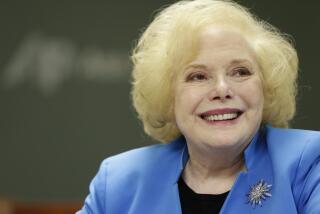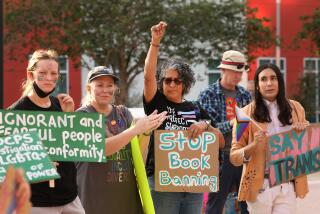Court’s TV Ban Led to Confusion : Television: A small camera would not have tainted King civil rights trial proceedings.
- Share via
A striking facet of the Rodney G. King civil rights trial coverage was television being constrained from doing what it does best--show and tell.
Although California and most other states allow the telecasting of court proceedings--and report no adverse results from that policy--cameras are still banned from federal courtrooms. If ever there were an argument for lifting that archaic ban, this latest King trial was it. Courtroom artists serve a function, but no matter how skilled, they’re no substitute for TV pictures.
Fascinating insights into a courtroom universe were available from KTTV-TV Channel 11’s gavel-to-gavel coverage of last year’s state trial of the four defendants in the police beating of King. Thus, it was outrageous that Los Angeles was deprived of that experience in the federal trial, and that the only electronic link to the trial was an audio feed available to reporters outside the courtroom for informational purposes, but not for broadcast.
It’s inconceivable that a small, stationary camera at the rear of a courtroom would have tainted or altered these proceedings. Tight controls inside the courtroom would have precluded anything even remotely resembling the flailing media frenzy that frequently occurred outside the Edward R. Roybal Federal Building. The two worlds are separate and distinct.
Meanwhile, what a bizarre sight to see TV reporters asking their colleagues and artists who were inside the courtroom to describe the reactions of the four defendants to the reading of the verdicts, as if they had been witnesses to an execution. And how equally bizarre, earlier, to have listened to TV reporters inside the press room relay the verdicts to viewers--a la radio--as they were announced inside the courtroom.
*
That was necessary because of an 11th-hour withdrawal of U.S. District Judge John G. Davies’ approval of live audio of the verdicts being announced inside the courtroom.
There had already been an audio flap earlier in the week when the judge had temporarily yanked KCBS-TV Channel 2 reporter Bob Jimenez’s credentials and threatened to close the press room when learning that his own voice was heard during one of Jimenez’s live updates. That violated an earlier order by the judge prohibiting stations from placing microphones near a press room loudspeaker that was providing audio from the courtroom. Jimenez and Channel 2 escaped punishment that time by convincing Davies that broadcasting the judge’s voice was inadvertent.
When it comes to steamrollering rules that other stations follow, however, Channel 2 takes a back seat to no one. Saturday affirmed that. As Jimenez relayed the verdicts to viewers, a voice reading the verdicts from inside the courtroom also could be distinctly heard. That appeared to be a clear violation of the judge’s rule.
None of this technological tangle would have occurred, of course, had a camera been inside the courtroom.
Meanwhile, here are more King trial leftovers:
* SEGUE FOR THE AGES. On Friday night, the Rev. Jesse Jackson was in the studio telling KNBC-TV Channel 4 anchors Paul Moyer and Colleen Williams that when it came to South-Central Los Angeles, there was a media plan, a police plan, a National Guard plan, but no urban development plan. Even in darkness, there should be some light, he urged.
Said Williams: “Rev. Jackson, you were saying we needed some good news. We have some good news. Fritz is ready to roll out his weekend forecast, coming up.”
* WOULD THEY LIE? A Channel 2 “Action News” promo is boasting about its coverage of the trial aftermath: “We dispelled the rumors and gave you the facts.” Uh . . . not always.
On Friday night, when there seemed to be a potential for panic in the city, Channel 2 falsely reported that Los Angeles police had been ordered on full mobilization in anticipation of Saturday’s jury announcement. In fact, the department was on a lower-level tactical alert, something other stations had reported accurately.
Plus, after Mayor Tom Bradley had publicly urged Los Angeles to ignore “all rumors and speculation,” Channel 2 anchor Bree Walker resurrected an old rumor. Saying she didn’t want to be a “rumor monger,” Walker asked reporter Jimenez Friday night what he knew of gossip about the King jurors supposedly sitting on verdicts they had reached three days earlier. Jimenez emphatically rejected this tall tale, which had been put to rest earlier in the week.
Using restraint, Walker did not bring up the lingering rumor that gang members had stolen 3,000 police uniforms. Or was it false noses?
* “RUMOR CONTROL.” In the wake of Saturday’s verdicts, a dangerous rumor buzz has been sweeping the city. Here are some of the, uh, tales reported to the volunteers working on our exclusive rumor control hot-line:
With the second King trial out of the way, Los Angeles Mayor Tom Bradley is planning a television address urging Tom and Roseanne Arnold to remain cool should ABC not renew “The Jackie Thomas Show.”
This, of course, is false. A source close to Bradley says that the mayor is already confident in the deterrent effect of the National Guard tanks that Gov. Pete Wilson had ordered to ring ABC headquarters here should the Arnolds attack.
If verdicts in the civil rights trial had not been reached by Saturday, the impatient media would have stormed the jury room and run wild through the streets of Los Angeles and its suburbs, looting, burning and committing senseless acts of violence.
That’s preposterous. The deadline was Sunday.
In hopes of spying on other reporters and the defendants and their lawyers, Channel 2’s “Action News” hid cameras inside the Roybal building restrooms.
You have to wonder how these silly rumors get started. Does the public think so poorly of the media? The truth is that “Action News” was getting all the information it needed from its microphones beneath the urinals.
More to Read
Sign up for Essential California
The most important California stories and recommendations in your inbox every morning.
You may occasionally receive promotional content from the Los Angeles Times.










